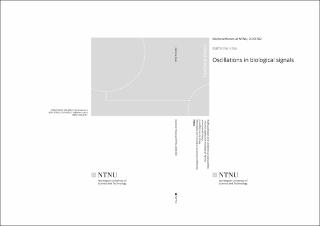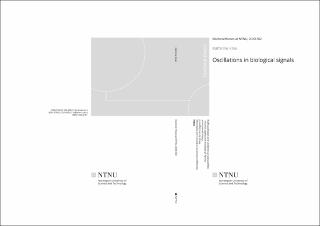| dc.contributor.advisor | Skjærvold, Nils Kristian | |
| dc.contributor.advisor | Aadahl, Petter | |
| dc.contributor.author | Knai, Kathrine | |
| dc.date.accessioned | 2020-10-19T12:26:04Z | |
| dc.date.available | 2020-10-19T12:26:04Z | |
| dc.date.issued | 2020 | |
| dc.identifier.isbn | 978-82-326-4953-2 | |
| dc.identifier.issn | 1503-8181 | |
| dc.identifier.uri | https://hdl.handle.net/11250/2683660 | |
| dc.description.abstract | This thesis is a study of electrocardiography, blood pressure and glucose signals in the search for oscillatory physiological processes that are of importance for resilience and the development of disease.
An oscillation is defined as a repetitive variation about a central value. Physiology shows oscillating behaviour over large spatial and temporal scales – from rapid variations of proteins and electrolytes on a cellular level to the female hormone cycle ranging over weeks and affecting the whole organism. The oscillatory processes are tightly linked to regulatory mechanisms, and several oscillations identified in biological signals are shown to be direct results of autonomic regulation. The loss of biological oscillations reduces the complexity of biological systems, which is seen with ageing and disease. It is believed that information about biological oscillations, if correctly extracted from biological signals, can be used in patient monitoring, diagnostics and prognostics.
In the first paper, we explore three different analyses’ capabilities for identifying oscillatory components in a blood pressure signal. We focus on time-frequency analyses, which capture the time-variability of the oscillations, and we illustrate how such analyses have different temporal resolution among low frequencies. In the second paper, we analyse glucose recordings from pigs, identifying a previously not reported oscillation with frequency 0.01-0.02 Hz. Further, we observe that the oscillations are not constantly present, but rather come and go. In the third and fourth papers, we analyse time series of heart rate, systolic blood pressure and R-wave amplitude in healthy and cardiac surgery patients, respectively. We identify oscillatory components in all variables and subjects, showing large interindividual variations. In paper three, we identify slow oscillations in R-wave amplitude and illustrate cases where they are synchronized with oscillations in systolic blood pressure and heart rate. In paper four, we do not see distinct changes in the oscillatory distributions after cardiac surgery.
The overall conclusion of this thesis is that the oscillatory distributions of electrocardiography and blood pressure signals of healthy and cardiac surgery patients are highly heterogenous and do not hold features that are either group-specific or common for both groups. Hence, we have not been able to identify information suitable for implementation in clinical decision tools. We are doubtful regarding biological oscillations’ capability of solely providing such valuable information. Consequently, there are major technological challenges that need to be overcome before automated tools are ready for clinical use. | en_US |
| dc.language.iso | eng | en_US |
| dc.publisher | NTNU | en_US |
| dc.relation.ispartofseries | Doctoral theses at NTNU;2020:302 | |
| dc.relation.haspart | Paper 1: Knai, Kathrine; Kulia, Geir; Molinas Cabrera, Maria Marta; Skjaervold, Nils Kristian. Instantaneous frequencies of continuous blood pressure A comparison of the power spectrum, the continuous wavelet transform and the Hilbert-Huang transform. Advances in Adaptive Data Analysis 2017 ;Volum 9.(4)
This is an Open Access article published by World Scientific Publishing Company. It is distributed
under the terms of the Creative Commons Attribution 4.0 (CC-BY) License
https://doi.org/10.1142/S2424922X17500097 | |
| dc.relation.haspart | Paper 2: Skjaervold, Nils Kristian; Knai, Kathrine; Elvemo, Nicolas-Andreas L.. Some oscillatory phenomena of blood glucose regulation: An exploratory pilot study in pigs. PLOS ONE 2018 ;Volum 13.(4)
https://doi.org/10.1371/journal.pone.0194826
This is an open
access article distributed under the terms of the
Creative Commons Attribution License (CC BY 4.0) | |
| dc.relation.haspart | Paper 3: Knai, K. & Skjaervold, NK. R-wave amplitude exhibits slow oscillations. An exploratory pilot study in healthy individuals | |
| dc.relation.haspart | Paper 4: Knai, Kathrine; Aadahl, Petter; Skjærvold, Nils Kristian. Cardiac surgery does not lead to loss of oscillatory components in circulatory signals. Physiological Reports 2020 ;Volum 8.(9) s. e14423-e14423.
https://doi.org/10.14814/phy2.14423
This is an open access article under the terms of the Creative Commons Attribution License (CC BY 4.0) | |
| dc.title | Oscillations in biological signal | en_US |
| dc.type | Doctoral thesis | en_US |
| dc.subject.nsi | VDP::Medisinske Fag: 700::Klinisk medisinske fag: 750 | en_US |

